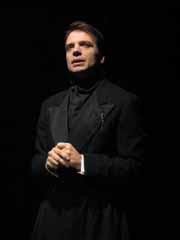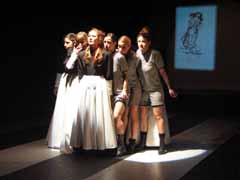
Litt
Crit
by Larry Litt
The Doctors Are In, The Patients Are Way Out: Two Plays, One Ailment
THE IMAGINARY INVALID
By Moliere
Resonance Ensemble
October 27 - November 19
Theatre Row's Beckett Theatre (410 West 42nd St.)
Adapted and Directed by Rebecca Patterson
SOME HISTORIC, SOME HYSTERIC
New Stage Theatre Company
Conceived by Ildiko Nemeth and Jessica Sofia Mitrani
Directed by Ildiko Nemeth
Clemente Soto Velez, 107 Suffolk St., NY
Nov. 10 to Dec 10, 2006
www.smarttix.com
The Imaginary
Invalid
Moliere's classic over the top comedy reappears from the Resonance Ensemble
with Argan played by exuberant Virginia Baeta in a wonderfully exaggerated
king drag. She plays much more alive than any old man suffering from just
about everything his doctors can diagnose. Moliere didn't conceive Argan
as a woman probably because women's roles were relegated to the romantic.
However Baeta understood the hypochondriac personality so well I saw through
her drag into the perpetually sick woman who uses doctors as her social
life. Baeta's comic timing carries the play, with it's all female cast,
on her shoulders throughout.
I think The Imaginary Invalid can be viewed as a metaphor for America's national health care crisis we're enduring today. We know insured individuals can demand attention from doctors and health care providers at will, while the uninsured patiently wait their turns in emergency rooms. Often when an uninsured patient is asked for their insurance carrier information a negative answer can result in inferior care or in some cases none at all. I ask, "Are the hypochondriacs among us using too many health services, too much insurance, occupying doctor's precious time while raising premiums? Is the only way to insure health care for a reasonable price to marry in or support a child through many years of schooling into the professions as Argan does? Or is it corporate pharmaceutical salesmen and health care administrators who are reaping the rewards of the body in pain and distress?"
Rebecca Patterson's adaptation of Moliere and direction of the all-female ethnically diverse company mixes archaic and modern language to create a period piece where proper amounts of respect and disrespect are evoked but still farce abounds. The only questionable moments come when the company provide musical interludes that drove me mad.
I have to mention Amy Driesler who valiantly played against type and convincingly made both characters Pulchinello and Thomas Diafoirus come alive. It ain't easy being a man.
 |
| Markus Hirnigel as Dr. Charcot |
A very severe, observant, reserved 19th century scientist was Dr. Jean-Martin Charcot, master of hysterical women at Salpetriere Asylum in Paris. His work with some 5000 committed women created neuropsychology and inspired Freud's psychology. He's also been the inspiration for numerous feminist theories, diatribes and artist explorations.
In this sweeping multi-media theater piece conceived by Jessica Sofia Mitrani and Ildiko Nemeth, also directed by Nemeth, actor Markus Hirnigel plays Charcot as a mystical idolizer-examiner of basically sad, frightened women escaping their unhappy realities and environments. Along with Dr. Charcot, "Some Historic/Some Hysteric" permits us entry into some of their wildly imaginative, colorful, and often artistic minds.
The scientific questions such as why and how and how long any human mind checks out are explored intimately with clocks, measuring devices and endless notes on the bodily functions of the young women in the cast. All portray their hysteria in the most natural way, as if somewhere in all women lurks the hysteric's potential, waiting for that singular pyrotechnical, emotional event to set them aflame.
 |
| Ensemble as patients of Salpetriere Hospital |
However, the asylum's bigger issue was how to help these patients, many of whom appear to revel in the asylum's safety. Dr. Charcot's acts of observation and experimentation with these fragile minds and bodies is the point of this movement and video extravaganza.
An exquisite Victorian interlocutor, played by Denice Kondik, explains and comments on Dr. Charcot's theatrical proceedings while he show off his patients at his Tuesday Lectures, demanding they perform their hysteria with their bodies. Is she too a former inmate, or another exploiter of this pathetic Theater of Hysteria? Is hysteria itself a state of theater she asks, in which the body and mind act out and through life's challenges until they are reconciled and the pain is manageable?
Using the writings of French feminist artist Claude Cahun as a multi-media statement of women's desires along side Freud's statements on hysteria and sexual agitation, this play gives us a complex insight into contemporary attitudes towards women's performance art. Are experimental performers basically hysterics? Are there hysterical influences that can drive art practice and perhaps create real hysteria in artists and audience?
It's no comfort that the fragility of women's lives are always subjects for artists in every genre and discipline. If there's anything about hysteria that comes across to me from this play it's that women artists should be caring for women hysterics. [Litt]
To contact the author write: larry.litt@yahoo.com

| museums | NYTW mail | recordings | coupons | publications | classified |